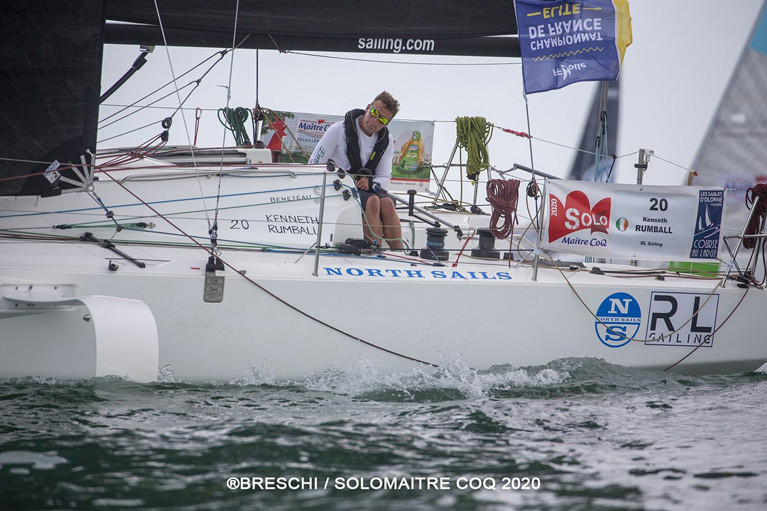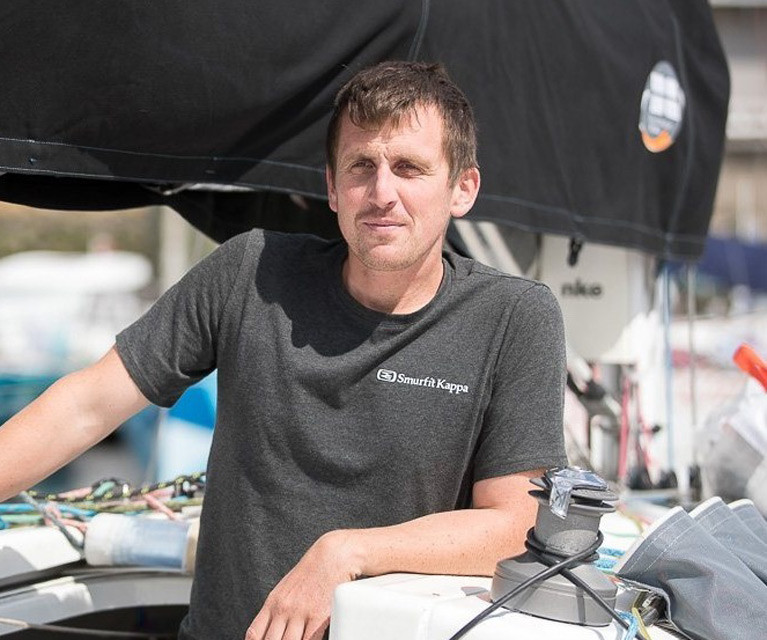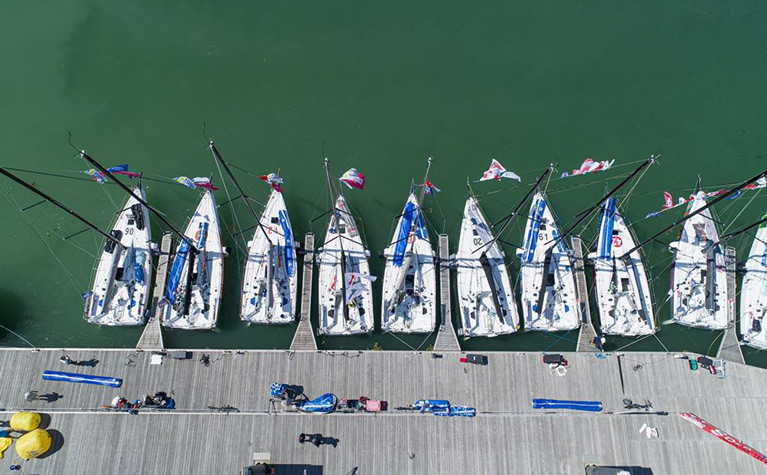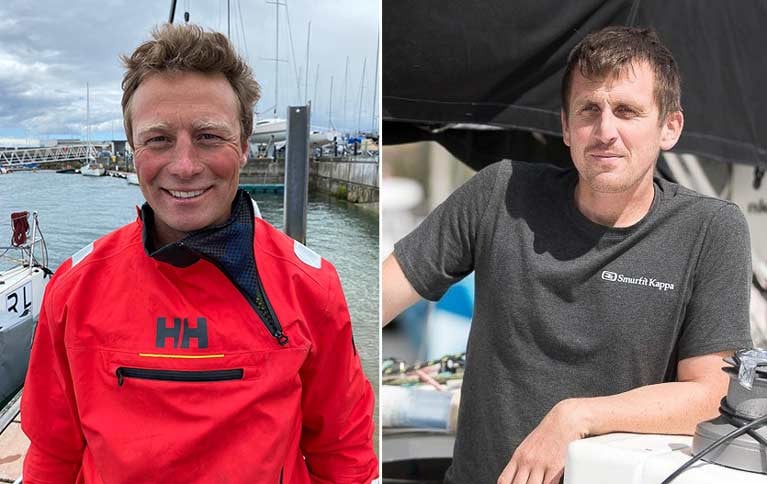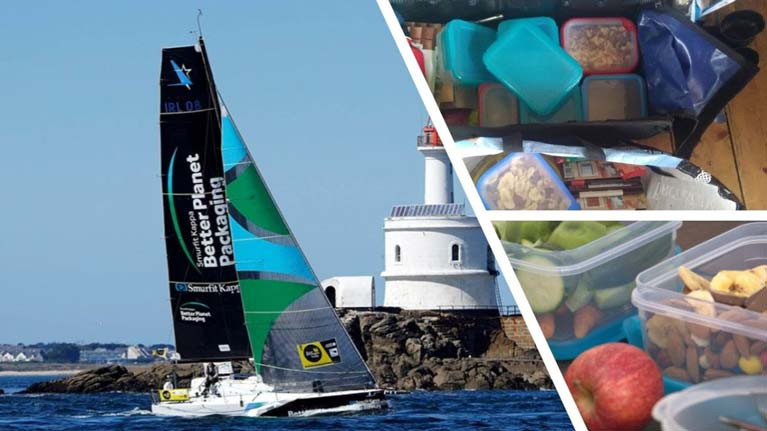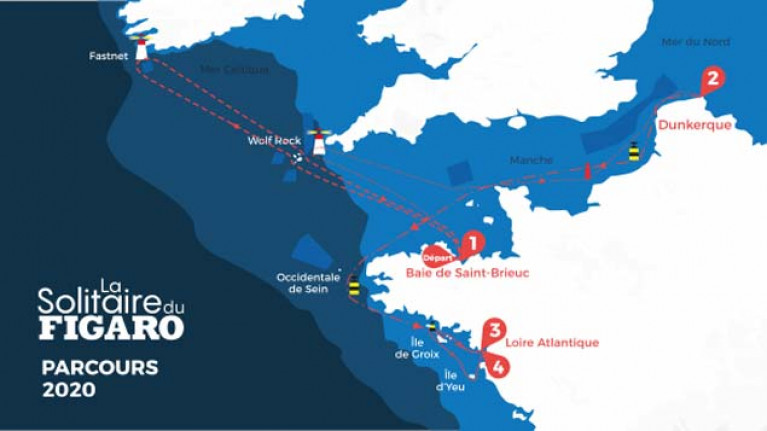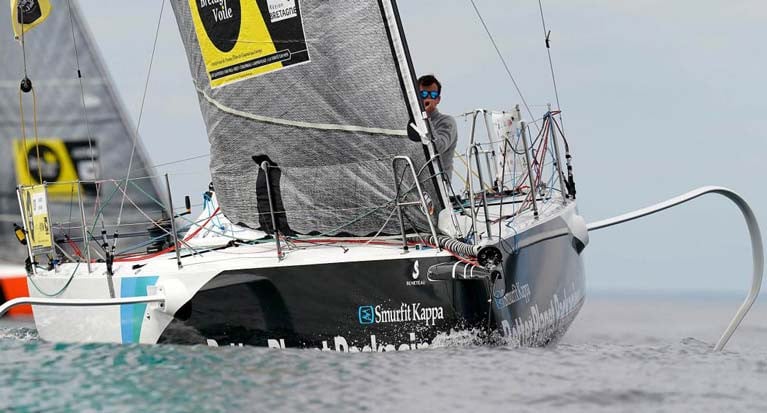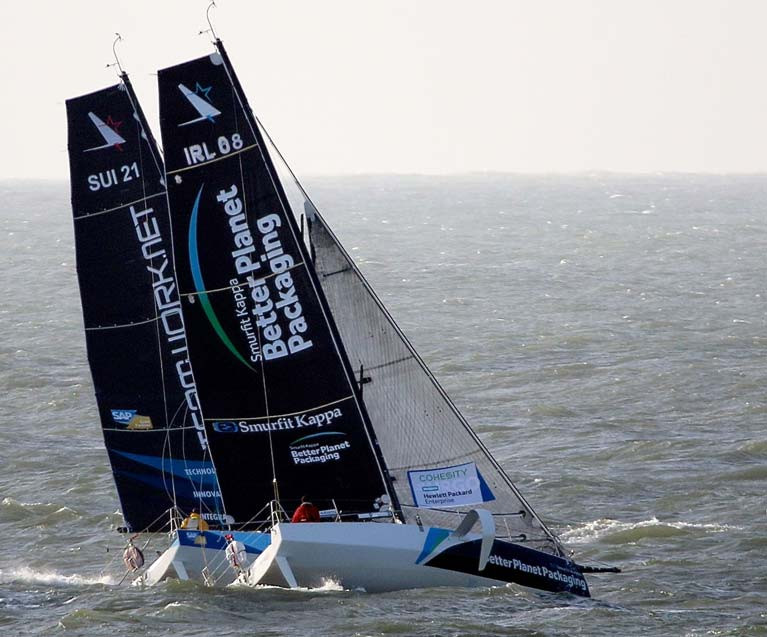Displaying items by tag: Tom Dolan
Dun Laoghaire's Rumball & Lee Ready for Drheam Cup as Dolan Teams Up With French Champion
Dun Laoghaire Harbour's Kenny Rumball and Pamela Lee make their double-handed debut for Ireland at the Drheam Cup on Sunday and joining them on the Figaro Beneteau 3 fleet start line are County Meath and French combination Tom Dolan and Mini Transat Winner François Jambou in what is the first major multi-class race on the French coast this season.
The 400-mile race mirrors some of what is likely to be part of September’s pinnacle event the La Solitaire du Figaro offshore in which Rumball and Dolan have their sights on.
Both Rumball and Dolan will be looking for a performance boost after both Irish solo sailors posted mixed results in the Solo Maitre Coq last month.
It will be the first time the Figaro Beneteau 3 fleet has been invited to race in this 100-plus boat event which has become a multi-class French offshore Grand Prix, set to feature the Ultime and IMOCA fleets too.
 Tom Dolan sailing with Mini Transat Winner François Jambou
Tom Dolan sailing with Mini Transat Winner François Jambou
The course starts from Cherbourg Cotentin and finishes in Lorient and first takes the fleet across the Channel to the West Shambles mark off Weymouth, westwards along the English coast to Wolf Rock off Land’s End and then back across the entrance to the Channel to finish at Lorient.
"We’ve had a bit of time off now with the boat in the shed getting antifouled and we had a chance to get the rig out ahead of the Drheam Cup. This we will do doublehanded, in line with the main aim of the programme" says Rumball who gives a nod to their Paris 2024 Olympic bid.
Dolan admits he did not do well on the Maitre CoQ. "That was disappointing so I am really looking forward to putting that behind me and sailing with Francois. We have been good mates for many years together and started a little business teaching and coaching people on the Mini, so we know each other well.” Dolan emphasises, “Our skills are complementary, we work well together. He has shown he can win races and so it will be good to have some fresh ideas and to be able to support each other. A second opinion is what you lack racing solo and so it will be nice to have that this time.”
The Drheam 2020 programme
- Thursday 16 July: Arrival of boats in Cherbourg-en-Cotentin
- Friday 17 and Saturday 18 July: Technical and safety checks
- Sunday 19 July: DRHEAM-CUP start
- From Tuesday 21 July: arrival of boats in La Trinité-sur-Mer
Early mistakes in very light and very fluky winds cost Tom Dolan dearly, leaving the Irish solo racer with no real chances to recover and make the solid opening he had wanted in the 340 nautical miles Solo Maître CoQ which finished on Saturday in Les Sables d’Olonne, France.
Dolan, sailing Smurfit Kappa, recovered a couple of hard-earned places in the latter stages of what was the first solo race of the 2020 season for the Figaro Bénéteau 3 fleet, to place 22nd.
He admits that once he had lost touch with the lead peloton on the mainly straight lines, reaching course there were not enough tactical opportunities to stage any kind of meaningful comeback.
The course off the Vendée took the fleet northwards in light winds from Les Sables d’Olonne to round the Ile de Yeu then a long southwards leg to the Ile de Re off La Rochelle. Dolan missed out on the first new breeze after a drifting start and then his losses were compounded by being on the wrong side of the next two rotations in wind direction.
“It is a disappointing way to start the season especially when we have waited so long to get racing. I know where I made the early mistakes and what is frustrating is that I didn’t really position myself early on to be able to follow my pre-race strategy which was to stay offshore where the new breeze was coming in from. I had it written everywhere ‘stay to the west’ but just could not get there in the breeze I had. Once I found myself in the east, to leeward you could not really climb back.” Dolan recalled Sunday after a decent night’s sleep. “Then it was all reaching.”
“ I sailed the boat well. I was fast enough and my manoeuvres were good and I take confidence in those fundamentals, but as ever I need to be with the lead group early on to really be able to sail the fleet rather than trying to catch up.” Dolan concludes.
Light Winds for Rumball v Dolan in Today's Solo Maître CoQ Offshore Race (Tracker Here!)
Lunchtime today effectively sees the first Irish battle on the long road to the Paris Olympic Games 2024 as two embryonic campaigns go head to head in the offshore keelboat discipline, in the French season opener, the Solo Maître CoQ.
Both Kenny Rumball and Tom Dolan are embarking on a journey for the single Olympic place in the new mixed offshore keelboat class that will ultimately see them sail double-handed with a female teammate but for now racing this season is on a solo basis, starting today.
Racing over a varied 340-mile course the rival Irish will compete against a high-quality field of competitors, it is an ideal warmup for the main objective of the season: the Solitaire du Figaro from 25 August-20 September.
"We're docked up in Les Sabes D'Olonne, the course is plotted, it's all happening...." declared the rookie Rumball on social media who has completed just a month's training in his new boat on Dublin Bay in June, as Afloat reported here.
The race starts and finishes in the legendary French port of Les Sables d'Olonne and takes the 30 solo skippers up and down the French Atlantic coast in what promise to be light and fickle breezes.
Last year's event comprised two shorter races and one long offshore but this year the race, which has been rescheduled from its original mid-March date, spans the coastline between Belle Ile in the north, level with Nantes, and at the southernmost extremity, the Ile de Ré off La Rochelle of what looks set to be a mainly reaching course.
County Meath solo racer Tom Dolan will also get his 2020 racing season underway.
"It has been a year since I have raced solo but even though I, like everyone else in this sport, have not been able to train on the water much I feel well prepared and itching to go. I spent time during lockdown reading and re-reading the key weather texts and doing on-line courses. I have worked hard on the mental side of my approach as well as doing all I could to bolster my obvious weakness, starting." Dolan explains, "So I feel ready to go. I do believe I have a better, more mature outlook which i hope will serve me well in this second season in the Figaro 3."
At 1300hrs local time Thursday racing starts offshore of the famous town which hosts the Vendée Globe solo round the world race and it should finish Saturday morning or early afternoon.
"It looks like it will be light, tactical sea breezes a lot of the time with some very light spells. To be honest, right now the start time looks very, very light. But I think it will be essential to get away with the first pack and not be left behind if you are to have a good chance."
Dolan is looking for a good race to kick off the truncated season but will not over-pressurise himself. The big goal is to be competitive for September's La Solitaire du Figaro. In essence, this course is very much a Solitaire dress rehearsal in terms of length and duration but the pinnacle event this year is mainly in the Channel, finishing into Saint Nazaire at the entrance to the Loire estuary.
"I have worked on my decision making processes and most particularly minimising how a small mistake can lead to a downwards spiral, making more mistakes because you increase your risks and make rash decisions to try and make your losses back. Far better to stay patient and maintain a solid work rate and wait for others to make mistakes. This game proves the sailors who make the fewest mistakes win," Dolan concludes.
Dolan says he is keen to represent his home nation in the mixed offshore discipline at the 2024 Olympics and is keeping an eye on what other sailors from Ireland and from different countries are doing.
Ireland will have two solo entries in next week's Solo Maitre Coq offshore race for the first time which starts and finishes in Les Sables d’Olonne.
Tom Dolan of County Meath and Kenny Rumball of Dun Laoghaire Harbour will go head to head in the Figaro3 Solo race, an important season starter that will ultimately see both campaigns compete in the gruelling Figaro race rescheduled for this September.
The pair will compete in an international 30-boat fleet that has some of the biggest stars in French solo sailing.
Since relaunching at the beginning of June the Brittany based racer, Dolan, from Kells, has been accumulating hours on his Figaro Beneteau Smurfit Kappa and, as Afloat reported here, is now making final preparations for what will be the first race of the season.
This will be Kenny Rumball's race debut since launching his campaign for September's Figaro circuit, as Afloat reported here, with a daily training routine on Dublin Bay over the past month. Rumball is now heading back to France preparing for the 270-mile Solo Maitre Coq and his first taste of the French offshore circuit and bringing with him some domestic competition for Dolan.
The fleet is packed with offshore sailing stars including Armel Le Cléac’h the IMOCA world champion in 2008 and French champion in a single-handed yacht race in 2003. Le Cléac’h notably won the Solitaire du Figaro twice and has finished second twice in the Vendée Globe.
Dolan has previously raced the Solo Maitre Coq, an important race on the Figaro circuit, finishing mid-fleet in 2019 as has Royal Cork's David Kenefick who took 17th place in the 2014 edition.
The full 2020 entry list is here
With the gradual easing of the French lockdown and offshore racing sailors now having returned to training, the future is again looking brighter for Irish solo racer Tom Dolan.
Since relaunching at the beginning of June the Brittany based racer, who originates from Kells, County Meath, has been accumulating hours on his Figaro Beneteau Smurfit Kappa and is now making final preparations for what will be the first race of the season, next week’s Solo Maitre Coq which starts and finishes in Les Sables d’Olonne.
“It will be nearly a year since I have raced solo, so yes there is a wee bit of rustiness, but it comes back quickly. It is like riding a bike in some ways, you don’t lose it, but you’re looking for the finesse to return, making manoeuvres smooth and instinctive, especially looking towards working on a dark night when you can’t afford mistakes.” Dolan asserts, “But for sure I can’t wait to be back out racing. It has been much too long.”
Tuesday day and overnight this week, Dolan is making a 24 hour offshore training sortie with the Lorient Grand Large group of which he has been a long time member. Until now he has just had four or five days training locally himself as well as some important corporate sailing with guests from Concarneau who were due to support him and co-skipper François Jambou with whom he was due to race the AG2R Transatlantic in April which was postponed until 2021. The duo also took key workers who were on the front line during the worst of the Covid-19 crisis out for a sail.
“Immediately the objective is to have the boat ready to pass the safety and measurement checks. There are still some water ingress issues which other boats still also have. The builders are working on it but it is not an ideal situation as we approach the second season with these boats.” Dolan comments.
With doubt surrounding the running of this year’s La Solitaire du Figaro for many months, the news that it will go ahead in September is a considerable relief for Dolan and all of the Figaro sailors.
“For a while, it was looking pretty grim, as if there might not be any racing at all this season. To their credit, Smurfit Kappa have been very supportive. They have been stretched through the crisis supplying packaging for essential supplies. They completely understood the situation.” Dolan concludes.
The Solo Maitre Coq race starts Thursday next week and should finish Saturday.
In the wake of the two-month lockdown from which it emerged on May 11th, France has reopened the coast and allowed all types of marine activities along the Atlantic. This is, of course, good news for Tom Dolan. The skipper of Smurfit Kappa, who kept busy during the two-month lockdown period, will launch his boat this week to get back training on the water.
"It's going to feel good to be back at sea after two long months, even if I feel a bit like it was non-stop. In mid-March, I made a long list of everything I wanted to achieve and I still haven’t reached the end yet!" says the Irish sailor, who managed to keep up a certain rhythm in his overall organisation.
“I tried just to keep to a normal schedule, getting up, getting dressed, working, and then switching off at the weekend and evening, except all that within 1km of the flat. People suggested that it must have been like being isolated at sea but I don’t see the connection much because we are doing what we love and by our own choice, I think I’ll pinch the quote of the great single-handed sailor Eric Tabarly who once said “Sailing means accepting the restrictions that you have chosen. It is a privilege. Most people are subjected to the obligations that life has imposed on them.” The only real comparison that I see between the two is our mindset as we come out of lockdown. The difficulty and the time it has taken to readapt to being around people reminds me a lot of coming back to land after weeks alone at sea.
A busy lockdown for Tom Dolan
"A good chunk of the weeks were made up of theory courses organised by our training centre in Lorient, all conducted by videoconference. During these sessions, we prepared in detail each leg of the upcoming Solitaire du Figaro, the dangers, important points of passage as well as local weather and tidal effects. Another week we worked on performance analysis and then I dissected the numerous traces of last season's races in order to work on the polar charts (graphical representations, expressing the speed of a boat as a function of the wind direction and strength) then the Sailects (creation and display of the places where the sails are used). I am starting to become a real geek (laughs)! I've also managed to get myself a bit more up to speed on all the paperwork involved in running a small business, which has never been my strong point. And then at the same time, I got to do a lot of catch up on physical preparation, doing a lot of muscle-building sessions and running around the house. I even lost a bit of weight, which is pretty good", explains Tom, who has set his sights once again on the famous Solitaire du Figaro, the only race on the class calendar which should remain in the running this season, if all the health and safety indicators stay in the green.
The Solaire du Figaro maintained for the time being, Plan B on the cards
"We will know on 15th June whether the race is to take place or not, and whether it will be on the scheduled dates (from 30th August to 20th September) or slightly later in September," explains the skipper of Smurfit Kappa, who keeps a plan B in the corner of his head in case the current pandemic turns the programme upside down once again.. "I have a great Plan B in mind, but it is top secret for now! So while waiting to find out more, I'm going to continue to prepare my boat in Concarneau. At the same time, we hope to organise sailing days with the teams from Smurfit Kappa as well as the different companies around Concarneau who had signed up to support us for the Transat AG2R La Mondiale and some of whom continue to accompany us. We will also take out the local council workers who kept working and supported the local community during the lockdown, such as the bin men, bus drivers and people from the town hall. We hope it will be a way we can thank them." concludes Dolan.
Fancy a little distraction? I've decided to show you some of the steps that we took to reduce waste during last year's Solitaire du Figaro writes Irish Solo Sailor Tom Dolan
Now more than ever we all need to think about what we buy, where it comes from and where it goes afterwards.
Snacks are difficult to choose; they need to be high in calories while at the same time being tough enough to survive banging around the boat for a couple of days.
So, we can quickly get lazy when shopping and buy things that are triple wrapped in single-use plastic, things that we wouldn't normally eat on land. So why do differently at sea? It took a bit of searching.
I found this great chocolate called 'Grain de Sail', which is manufactured in Brittany. The raw materials (green coffee and cocoa) come mainly from the Caribbean and Central America and are sourced equitably. The company are building their own sailing boat in order to transport the raw materials under sail! Their packaging is made entirely of paper and to top it all off it is very, very good!
I bought dried and fresh fruit and stored it in reusable Tupperware boxes along with cold meats and portions of cheese all from the local market or shop and again wrapped in paper.
- Sacrifices: Babybel, Snickers and penguin bars!
- What I saved: A little under one small bin bag full of single-use plastic packaging
- Shopping list: Lots and lots of reusable Tupperware!
On 30th August in Saint Brieuc bay, France it is going to be a demanding and difficult start for the 51st edition of the Solitaire du Figaro for Ireland's solo sailor Tom Dolan and the rest of the foiling Figaro 3 fleet.
After achieving 25th place last year, Dolan is set to re-enter this three-week-long French marathon race.
It looks like being a fascinating programme with four legs to be raced, three of which are 500 miles long and more, which is the sort of racing the sailors love. They will then face a final 24-hour run to complete this marathon. Among the highlights, the Fastnet and Wolf Rock stand out in this racecourse with several Channel crossings, the need to deal with the shipping lanes and sandbanks all the way to Dunkirk, then the rocks and tidal currents all the way down to Loire-Atlantique.
Francis Le Goff, the Race Director, has once again decided to leave things very open with few marks along the way, in order to allow the solo skippers to find their own strategy. This looks like being a classic edition with an exciting finish in prospect at the mouth of the Loire…
With some keen newcomers aiming to discover the delights of the Figaro Beneteau circuit (Robin Follin, Erwan le Draoulec, Elodie Bonafous, Estelle Greck...), some who are used to the event (Xavier Macaire, Anthony Marchand, Alexis Loison...) and some previous winners, including the winner of the last Vendée Globe, Armel le Cleac’h, more than thirty competitors are expected to line up in Saint- Quay-Portrieux on 25th August. Aboard their Figaro Bénéteau 3 foilers, the skippers are going to have to remain determined and focused to try to win the Holy Grail of sailing in Loire-Atlantique at the finish of the third and final leg. This year, the Solitaire du Figaro will be returning to the Pays de la Loire region, which proved so popular during the fiftieth edition in 2019 with the start in Nantes.
Analysis of the racecourse by the Race Director:
Leg 1: a 642-mile voyage to the Fastnet and back
“The only waypoint in this first long leg will be the Fastnet Rock, which they will have to leave to starboard. It is going to be very open for the solo sailors from the start, with everyone attempting to find the right tactics and avoid the traps in the Channel and the Celtic Sea,” explained Francis Le Goff. Once they have left Saint-Brieuc Bay, the skippers will head for Ireland while avoiding the rocks around the Isles of Scilly and respecting the various shipping lanes (TSS) to the West of Cornwall on the way out and back. Anything is possible.
They can go inside or outside the islands, so we can look forward to an exciting tactical game…
Leg 2: 497 miles to Dunkirk via the English coast
They will have to watch out for all the shipping and sandbanks. “From Saint-Quay-Portrieux, the fleet will head for the Wolf Rock to the South West of Land’s End, and then make their way towards a waypoint close to Antifer light near Etretat before heading for the finish off Dunkirk. In this leg, they are going to have to make sure they are able to remain alert and focused over the final miles. “This is a leg, where keeping a clear head for the final few miles will be key to the outcome,” explained Francis Le Goff. In this second leg, it will all be very open between Wolf Rock and the Alabaster Coast of Normandy, but there will also be a lot of traps lying in store, such as the TSS, which means the room for manoeuvre will be limited all the way to Dunkirk. There is all the cross-Channel shipping between Calais and Dover, and then the tidal currents and sandbanks all the way to the finish. They will have to manage their sleep and that is going to be vital in this leg for them to be able to stay fresh for the final stretch…
Leg 3: a 504-mile coastal leg from Dunkirk to Saint-Nazaire
There are going to be some great sights along the way in this third leg with a wide range of backdrops. The Opal, Alabaster, Mother-of-pearl coasts of Normandy and the Pink Granite coast and craggy cliffs at the tip of Brittany, the Megalithic Coast of Southern Brittany, the Love Coast and Jade Coast of the Loire Estuary area. So many brilliant things to see, yet the leg is full of hurdles: tricky headlands and capes, tidal currents, islands and rocks, fishermen… 500 miles of high-tension sailing, with one eye on the charts, and the other on the sails with some sleepless nights ahead.
Leg 4: a 24 hour and 183-mile sprint between the islands for the Grand Finale
After three hard, testing stages, the solo sailors will have to draw deeply on their reserves for 24 hours of racing, a loop which should take them between the Ile d'Yeu and Belle-Île via the Ile de Groix before seeing them return to the Loire-Atlantique to crown the big winner of this 51st edition which promises to be full of twists and turns.
From tomorrow, the publication of the Notice of Race will open entry registration for this 2020 edition.
The Coronavirus outbreak has caused French organisers of the Solo Maitre Coq and the Transat AG2R La Mondiale to delay both events and with it the plans of Irish solo sailor Tom Dolan for an Irish bid in the Transatlantic Race.
For now though, County Meath's Dolan, who is based in France, must sit and wait to find out how the French Offshore Racing Championship will be reorganised before the Solitaire du Figaro race begins this summer.
"I'm keeping busy with physical exercises, weather classes offered by Lorient Grand Large and a lot of paperwork", Dolan said on social media.
Also as Afloat reported earlier, Dolan is expected back to Irish waters for trialling with a new female sailing partner in a bid to represent Ireland in the World Offshore Sailing Championships. As also reported previously, these trials will now be sailed as part of June's SSE Renewables Round Ireland Race from Wicklow.
Tom Dolan to Trial Irish Female Sailors for Two Handed Offshore Class for the Paris 2024 Olympics
After April's Transatlantic race, Irish solo sailor Tom Dolan is planning to bring his boat Smurfit Kappa to Ireland for six weeks to trial some potential female sailors with a view to forming an Irish campaign for the two-handed offshore class for the Paris 2024 Olympics.
“I have had a couple of women who are interested approach me and so we will do some sailing and see how we get on. But this period will also allow me to do some data analysis with an Irish company who are keen to help me generally on data and performance analysis.”
The Transat AG2R will be a big test not just for the two co-skippers but for the Figaro Beneteau 3 boats which have never raced on such a long ocean passage.
“Keeping the boats dry below and stopping water coming in is the big test. There were problems enough on La Solitaire in the Celtic Sea so we really have been working on what can be done.” He explains, “I am really looking forwards to racing hard two-handed to be able to really push the boat. And there should be a chance for a good rest afterwards. La Solitaire is what matters and I want to be doing all I can to arrive at the start rested, focused and ready to put three good, solid legs together.”
Solo Maitre CoQ Starts on Monday
The 2020 season for the Figaro class is fast approaching with the Solo Maitre CoQ due to start in Les Sables d’Olonne, France on Monday. Irish solo racer Tom Dolan is pleased to have achieved a much more balanced, clearly focused build-up seeking to make last year’s weaknesses into strengths and return a set of consistent good results.
The Solo Maître Coq comprises two days of coastal courses followed by a two-day offshore race and is an important warm-up, a chance to benchmark against the fleet following the winter and early spring training period. It is an opportunity to check the boat is perfect before April’s demanding Transat AG2R from Concarneau to Saint Barths in the Caribbean. The pinnacle event of the season is once again La Solitaire du Figaro which takes place in September.
“One thing I have been working hard on is my personal preparation and management ashore and afloat.” Dolan asserts, “ Last year with the boat being new it was a bit of a mad scramble for everyone to find the time to train and to prep and optimise the boats. Maximising sailing time whilst requiring time to fix and optimise the systems, and remember it was all compressed by technical faults, all added up to a tiring, stressful season. Looking back that definitely impacted on my decision making and for sure making wrong decisions impacted much more on my season than any lack of boatspeed at any one time.”
“I am just trying to be more disciplined on and off the water so I can put myself in the best position to make good decisions when they really count.”
“So I am working from my programme as much as possible that makes things like safeguarding days off and not sliding into working on the computer and messing with the boat. Rest is vital and he has been taking time to learn from the meteo books and doing as much homework about the race courses, looking at different scenarios now so I feel prepared. I have just re-read all the information about the Vendée weather for example whereas this time last year I was worried about if blocks were in the right place.”
Dolan has worked hard on his pre-season preparation with his sailmaker Technique Voiles and feels he has made further gains. “It is a work in progress as it always is but with the cable-less gennakers I feel there is a definite gain but we will have to see against the whole fleet.




























